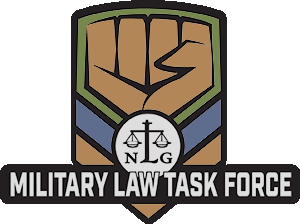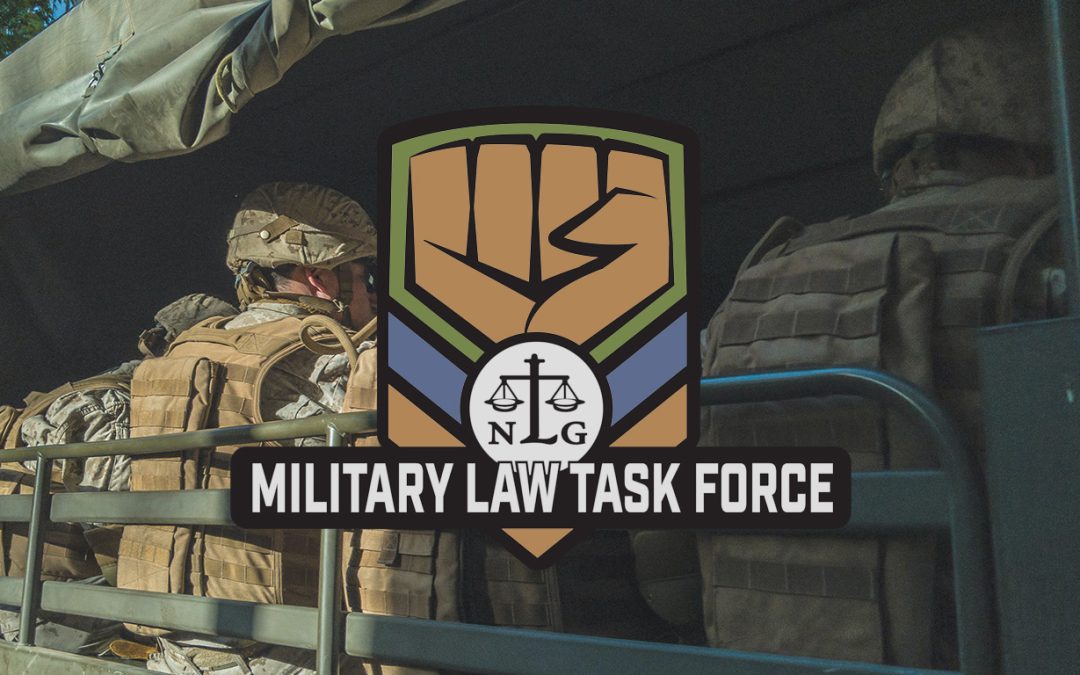BY BILL GALVIN AND MARIA SANTELLI
Staff, Center on Conscience and War
There is an update to this article.
Imagine: you just worked a full week at your civilian job. Friday evening comes, but instead of going home and getting a good night’s rest before drill weekend, you have to get in the car and drive six (or more) hours to drill. The next day, with just a few hours of sleep on the floor of the armory, you are up before the sun to perform two full days of rigorous military training. Sunday night, you get back in the car to head home, exhausted. Your Sergeant pats you on the back and tells you to be sure to drink a couple of Red Bulls and text him when you get home.
This is not safe, and it is not lawful. Yet, every day, the GI Rights Hotline gets multiple calls from Reservists and National Guard members who are being told they must travel excessive distances to drill. Even though someone may have moved hundreds – or even thousands – of miles away from their unit, commanders and non-commissioned officers (NCOs) frequently will not offer the slightest hint of support or relief.
Federal regulations define the “maximum distance a member of a Reserve component may travel involuntarily between residence and drill training site.” For enlisted members, that distance is
“A 100-mile radius of the drill site that does not exceed a distance that can be traveled by automobile under average conditions of traffic, weather, and roads within 3 hours. This applies only to those units that normally conduct four drills on 2 consecutive days during the training year, if Government meals and quarters are provided at the base where the unit drills” (32 CFR par. 100.6).
For officers, or for enlisted personnel in units that do not normally drill on 2 consecutive days, the maximum distance is 50 miles, and 1½ hours driving time. For a member commuting between 50 and 100 miles, the unit must provide a place to sleep and meals.
While most folks are assigned to units that are within the commuting distance, people can end up outside of the commuting distance if they change their residence for work, school, or a variety of other personal reasons. Sometimes units relocate or become inactivated. At times, Reserve members will agree to voluntarily travel beyond the maximum commuting distance for various reasons.
Each branch of the military has regulations about maximum commuting distance, and, as usual, Army regulations provide the most detail.
Army Regulation 135-91, which details Reserve participation requirements, defines the the
“Maximum Involuntary Travel Distance” in paragraph 5-5. The language is virtually identical to the CFR cited above. This regulation also gives good detail on the procedures to follow when an individual soldier relocates their permanent residence. Paragraphs 4-19 through 4-24 instruct the soldier on their responsibilities, with respect to notifying their command of their relocation, and the command on their role in assisting the soldier in their transition. The soldier must notify the unit commander, in writing as soon as they know about the upcoming move, providing their new address when they have it. “[S]oldiers who give notice of relocation will be transferred/reassigned to the area of their new address” (AR 135-91 par. 4-19.b(1)).
The unit commander has the responsibility to help the soldier find a new unit that is within commuting distance of their new location. For those in the Guard, the commander should seek assistance of the appropriate State Adjutant General. For Reservists, the commander should seek help from the Major U.S. Army Reserve Command through the USAR REQUEST System. The gaining unit commander determines whether or not to accept the soldier based upon “vacancy and qualification criteria.” If the transfer has not happened by the time the soldier moves, they are to be granted a 90-day leave of absence while placement in a new unit is arranged. That means that the soldier is not required to be drilling at the old unit or even re-scheduling training (RST – making up missed drills) at a temporary placement near their new home. A soldier also cannot be forced to reclass in order to find permanent placement in a new unit (DODI 1215.13, enclosure 3).
If, following the end of the leave of absence, a new unit has not been found that is within commuting distance, has an opening in the soldier’s MOS and is willing to accept soldier as a transfer, then “[o]n the 95th day . . . the soldier may be reassigned/transferred to the IRR” (AR 135-91, Paragraph 4-24).
The other branches of the military do not provide as many procedural details in their regulations, but the basic policy applies in all branches.
AFI 36-2110, paragraph 8.3 contains the rules for relocation of Air Force reservists, who should be reassigned to the same job they hold prior to moving. And for members of the Air National Guard, “when members change their place of residence… [and] are located outside a reasonable commuting distance of their present unit and not within a reasonable commuting distance of another ANG or Reserve unit, the member may request to be separated or discharged. . .” (AFI 36-3209, paragraph 3.12.3.4.).
For those in the Navy, the procedures are spelled out in MILPERSMAN 1133-062, paragraph 5.d. For the Coast Guard, the guidance is found in COMDTINST M1001.28C.5.C.
For Marine Reservists, the Marine Corps Reserve Administrative Management Manual (MCRAMM), para 4.1.d. spells out the procedure for members who move. The most significant difference for Marines is that they can transfer to units that do not have an opening for their MOS. The Manual actually says, “When there is more than one SMCR unit within reasonable commuting distance, the mandatory participant will be joined to the unit for which the Marine is most closely MOS qualified” (MCRAMM 4.1.d(1)(a)4.).
To be clear: no Reservist can be required to travel more than 100 miles between where they reside and where they are assigned to drill. So if the command has no authority to require someone to travel an excessive distance, they also do not have the authority to charge them with an unauthorized or unexcused absence if they don’t come to drill.
THE PROBLEM
Commands routinely charge Reservists with unexcused absences if they refuse or are unable to volunteer to travel the excessive distance. A frequent refrain: “You chose to move. The Army [or Navy, etc.] didn’t make you move. You have a contract and an obligation to this unit, so you must come to drill or you will be marked AWOL or UA (unauthorized absence) for this drill.” Missing nine unexcused absences in a 12-month period gives the command authorization to separate the member, and if the paper trail documenting the excessive distance is not robust, the command could get away with giving the member a characterization of Other Than Honorable (OTH).
Often the Hotline receives calls from someone who has been traveling hundreds of miles to drill for many months because they didn’t know about this regulation and their unit didn’t tell them. When financial hardship (a member is not automatically entitled to reimbursement of travel expenses, such as airfare or rental car) or car trouble causes the member to reach the end of their rope and say they can no longer make the excessively long trip, they are often threatened, ridiculed, and coerced by their command. One notable case was a member who had been transferred for his civilian job from Texas to Indonesia. He was flying back to drill with the Texas National Guard every month, at a personal expense of $2000 per weekend. His unit never once indicated that doing anything but flying back to Texas each month was even an option. After amassing a mountain of personal debt, the soldier finally reached out to the Hotline, and we were able to advise him of the regulation his command was willfully violating.
We also have heard from callers who turned down lucrative job offers or other opportunities after their unit told them they couldn’t move because they were obligated to the local unit.
Unfortunately, simply calling attention to the appropriate regulation does not usually resolve the problem. Commands often fire back, saying “that regulation doesn’t apply to you,” or “that’s an old regulation,” and they become even more entrenched in refusing to follow the regulation. In these cases, a strong paper trail and tenacity on the part of the member are key. A good paper trail would consist of a memo citing the regulation, documenting the circumstances that resulted in the member traveling the excessive distance, and documenting any hardship the travel causes. It can also be helpful for the member to make the direct request for the relief that they seek (e.g., transfer to a closer unit, if possible, or transfer to non-drilling Reserve status – IRR or ING). Sometimes a member can make progress by directly questioning the command on why they believe it is okay for them to try to force the member to travel the excessive distance: “Please provide me with a copy of the regulation that gives you that authority.” No such authority exists. But the commands don’t give up that easily. We have seen commands literally make things up. A California National Guard commander actually stated that there was a California law that superseded Army regulations and gave the Guard the authority to violate the commuting distance rule. (Spoiler: there is no such law.)
Sometimes we try to talk with the command and reason with them. The approach that has had some success is this: It is clear that the intent of the regulation – and the spirit of the Reserve component – is to allow individuals to have a thriving civilian life, as well as a part-time military career. If the member was in the active duty, the military would control most aspects of their life, including where they live. But when a member joins the Reserves or the National Guard, they understand that they are committed to a weekend a month, a couple weeks a year, and that they are on call, if needed.
Otherwise, they live a normal civilian life, in which they may have a family, a job or be in school. Civilian life takes them where it will, and the regulations are written with this understanding.
Frustratingly, reasoning usually doesn’t work, and an Article 138 letter requesting redress or congressional intervention may be required to convince the command that they are required to follow the regulations.
What often happens when the member stops traveling the long distance to drill is that the unit will mark them unexcused (give them U’s). When a Reservist has accumulated eight U’s, the unit is authorized to warn them that they are approaching unsatisfactory status, and at nine U’s, they can be separated. For National Guard members in a handful of aggressive states, members could also face the additional risk of an arrest warrant being issued for unexcused absences. This is not what should happen, and can be prevented with a strong paper trail meticulously documenting the relevant issues and the failure of the command to follow the regulations. It is important to advise Reservists to be proactive in communicating with their commands. Most commands ignore verbal pleas from members, and many will ignore even written documentation, so consistent follow up by the member is critical to ensure a positive outcome. We recommend that correspondence be made in a way that is trackable, such as email or certified mail.
When a member receives notice that they are approaching unsatisfactory participation status for not attending drill, they must respond – hopefully by drawing the command’s attention to the already established documentary paper trail, and increasing it with any new evidence acquired since the last communication. When they eventually get the packet informing them that they are being discharged with an OTH for unsatisfactory participation, among those papers will be a series of rights they may elect as a channel to fight the discharge, the characterization, or both. Those rights include examining the evidence being used against you; entering evidence on your own behalf; and having access to a military attorney to assist you in preparing your case. This is exactly why a meticulous paper trail documenting the chain of events is critical. If an OTH is threatened, every member has a right to a separation board to argue their case; if the characterization offered is Honorable or General Under Honorable Conditions, only members with six years or more of service are entitled to the board.
While each person will decide the best way to respond, and some are just so burned-out from what very well could have been months of wrangling with their command over this, we do not recommend signing anything that amounts to waiving their rights and consenting to this discharge, especially with an OTH. Often, commands will offer or members can request a “conditional waiver” of their rights, meaning they won’t contest the discharge on the condition that they receive an honorable discharge (or sometimes a general under honorable), as they did not violate military regulations
RELATED PROBLEMS
Sometimes commands say the person cannot be transferred to a unit nearer to their home because they are flagged, or because they don’t have a recent medical clearance, or some other basis. In such cases, it is important to inform the command that regardless of these things, there is still no regulation that requires the member to travel outside the maximum involuntary travel distance. One option for the command would be for them to be retained in their original unit while these things are being resolved but allowed to drill with a unit that is within commuting distance of their current residence. According to DOD regulations, many flags are transferrable, but some state regulations are stricter and will not allow transfer under certain conditions, such as failed PT.
As mentioned at the beginning of this article, reservists sometimes agree to travel a distance outside of the maximum commuting distance. In such cases they usually signed a waiver to that effect. Commands will sometimes use this to deny a unit transfer. In one such case, the member lived just a couple miles outside of the commuting distance and was willing to travel the distance. When she moved hundreds of miles away, the unit claimed they didn’t have to transfer her because she had already submitted a waiver. In these cases, it can helpful to document what has changed in the member’s life that no longer allows them to “volunteer” to travel the excessive distance, and as we all know by now, they cannot be required to do so.
A GI Rights counselor, frustrated with the obstinacy of commands, passes this request along to MLTF: “It drives us crazy the amount of time we have to spend on these cases, and it would really be beneficial to the cause if there were some court case that could settle once and for all that a command is acting against the law when they insist someone continue to drive beyond commuting distance or face penalties. I know it’s a long shot, but maybe someone in MLTF would be inspired to take up the cause.”
But until that happens, we are standing by to take these calls on the Maximum Commuting Distance Hotline, sometimes known as the GI Rights Hotline (girightshotline.org).
The Center on Conscience and War’s website is at centeronconscience.org.



